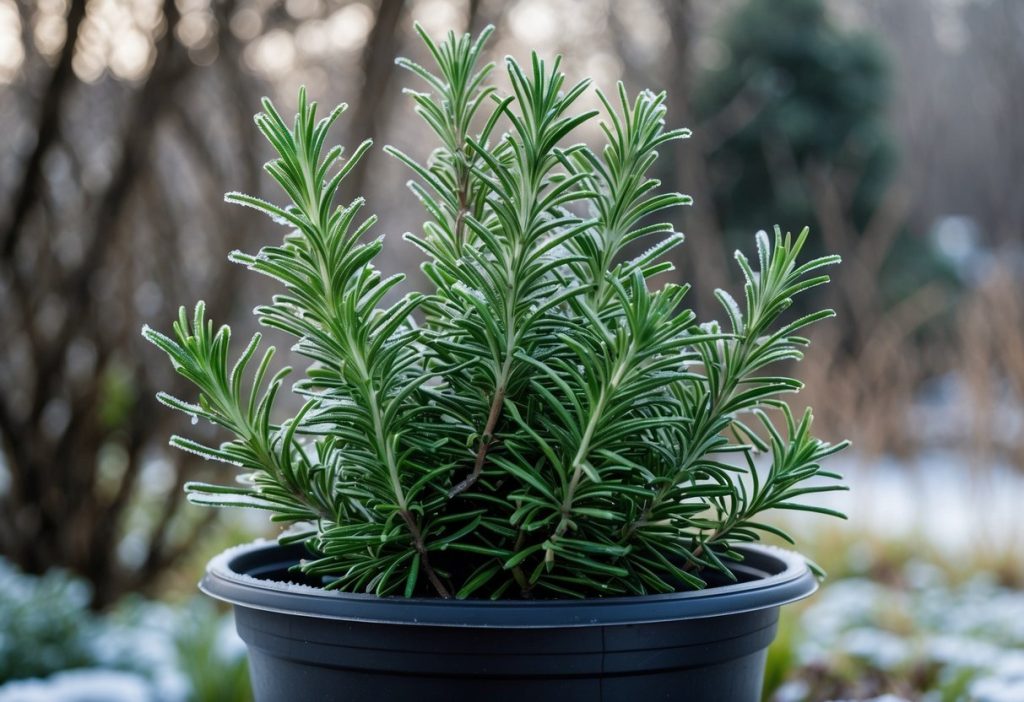
During the summer months, it’s easy to grow a wide variety of fresh, flavorful herbs almost anywhere in the United States. But some of our kitchen favorites are native to warmer climates and struggle to survive cold winters. Rosemary (Rosmarinus officinalis) is one popular perennial herb that needs some extra TLC to get it safely through the winter.
Your best strategy for getting rosemary through the winter will depend on where you live. Rosemary is generally hardy in zones 7 through 10. Some varieties, especially those adapted for cooler climates, can be overwintered outdoors as far north as zone 5b.
If your climate is colder than that, your best bet is to grow your rosemary in a pot and bring it indoors for the winter. This article from the Wisconsin Extension offers some advice on how to keep rosemary healthy indoors: .
If you live in zones 5b-7, follow these steps for overwintering:
Planting and Preparation
Choose your Varieties
Select a variety of rosemary that’s specifically developed to survive in cold climates. Recommended varieties include:
- “Arp” (the most frequently mentioned)
- Madeline Hill
- Nichols Select
- Hill Hardy
- Salem
- Nancy Howard
- Dutch Mill
Pick your Pot and Prep your Soil
Tender herbs like rosemary have a better chance of surviving the winter in a protected spot. This means three things:
- Keep them warm. You might set them against a south-facing wall, which will collect warmth from the sun and radiate it back slowly overnight.
- Protect them from prevailing winds—use walls, slopes, or tall bushes to shield them. (If your winds come mainly from the south, you may have a problem getting adequate wind protection as well as adequate light and warmth.)
- Plant them in well-drained soil. Soggy soil makes winterkilling much more likely.
Fall Preparation
Stop fertilizing your rosemary plants in August. Don’t prune them heavily in or after August either. Doing either of these things may prompt a surge of new tender growth that will winterkill.
Freeze Protection

There are two different ways of managing rosemary outdoors in cold winters. Remember that unprotected rosemary can survive temperatures in the 20s, so you don’t need to protect it against light frosts.
Method 1: Cutting Back to Stumps
The North Carolina Extension recommends cutting rosemary plants to within 2 inches of the ground after the first hard frost has passed. Cover the stump with soil. Then cover that soil with 4 or 5 inches of mulch. As with other plants that get deep winter mulch, you should rake back the mulch in spring as the soil warms, allowing the plant to regrow from its roots.
Method 2: Covering
You can also leave the top growth on your rosemary plant and insulate it. There are several ways of doing this.
- The simplest is to surround your rosemary plant with a cylinder of chicken wire, a tomato cage, or a circle of stakes and fill this cage with dry leaves.
- You can also wrap your rosemary plant with burlap (with or without leaves inside).
- Or you can buy a wall-of-water-style insulator made of soft plastic segments filled with—you guessed it—water. Placing a tomato cage or other rigid barrier around the wall of water will prevent it from getting punctured.
These approaches will work better if your rosemary plant has been trimmed so that it’s reasonably compact and doesn’t have low branches trailing on the ground. You’ll still want 2 or 3 inches of mulch over the plant’s roots.
Other Tender Perennials to Overwinter Outside
Master gardeners offer different lists of tender herbs that can usually survive cold winters outdoors with extra protection. Details vary depending on your climate. These are some of the tender perennials that you may be able to treat like rosemary.
- Horehound (Maribium vulgare)
- Hyssop (Hyssopus officinalis)
- Lemon verbena (Aloysia citriodora)
- Sweet marjoram (Marjorana hortensis)
- Sweet woodruff (Galium odoratum)
- Tarragon (Artemisia dracunculus)
To learn more about the hardiness of different herb varieties, visit the North Carolina Extension publication on winterizing the garden.
Overwintering Herbs in Pots

You can overwinter some herbs in pots outdoors. This may not work well if your winters are consistently very cold, since pots will freeze harder and faster than your garden soil.
In fact, some experts say plants overwintered in pots are exposed to conditions one zone lower than plants grown in the ground in the same yard. For instance, if you live in zone 7, your potted herbs will be effectively growing in zone 6. If they’re hardy to zone 7 but not to zone 6, plan to overwinter them in the ground.
But you might be able to bring potted herbs into a sheltered or insulated place during a freak cold snap, which isn’t possible with in-ground herbs. Better Homes and Gardens recommends overwintering herbs in plastic pots, since clay pots are more likely to break as they freeze and thaw.
Summary
With careful management, you can keep rosemary and other tender herbs alive outside through moderately cold winters. You won’t get to harvest from them during the winter, but they’ll be ready to start growing robustly again in spring.
